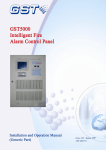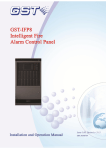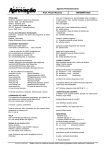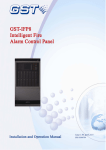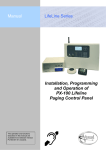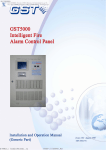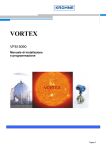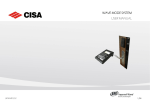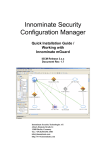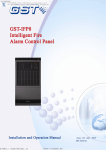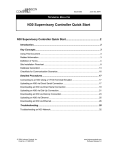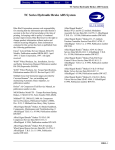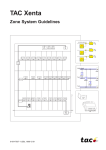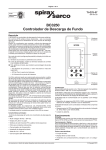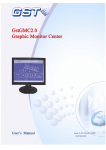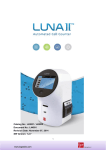Download GST200-2/1 Intelligent Fire Alarm Control Panel
Transcript
GST200-2/1 Intelligent Fire Alarm Control Panel Installation and Operation Manual CONTENTS Installation Precautions ............................................................................................... 1 Preface EN 54 Information ........................................................................................... 2 Chapter 1 Product Introduction................................................................................... 3 Chapter 2 Technical Specifications ............................................................................ 4 2.1 Operating Voltage ................................................................................................. 4 2.2 Standby Batteries .................................................................................................. 4 2.3 Communication Loop Parameters ........................................................................ 4 2.3.1 RS485 Communication Loop .................................................................... 4 2.3.2 RS232 Communication Loop .................................................................... 5 2.4 Detection Loop Parameters .................................................................................. 5 2.5 Output Loop Parameters ....................................................................................... 5 2.5.1 FIRE ALARM OUTPUT (+, -) .................................................................... 5 2.5.2 F.P.E. OUTPUT (+, -) ................................................................................ 6 2.5.3 SOUNDER CIRCUIT OUTPUT (+, -) ........................................................ 6 2.5.4 FAULT OUTPUT (NC, COM, NO) ............................................................. 6 2.6 Dimensions............................................................................................................ 6 Chapter 3 Construction and Components ................................................................. 7 3.1 Appearance and Internal Construction ................................................................. 7 3.1.1 Display Area .............................................................................................. 7 3.1.2 Description of LEDs .................................................................................. 8 3.1.3 Description of Keys ................................................................................... 9 3.1.4 Zone Indication and Manual Interventional Panel (ZCP)........................ 10 3.2 Components ........................................................................................................ 11 3.2.1 Standard Components ............................................................................ 11 3.2.2 Optional Units .......................................................................................... 11 3.3 Peripheral Devices .............................................................................................. 13 3.3.1 A Series of Intelligent Fire Detectors ...................................................... 13 3.3.2 Modules ................................................................................................... 13 3.3.3 Loop Isolator ........................................................................................... 13 3.3.4 Manual Call Points .................................................................................. 13 3.3.5 Sounder Strobes ..................................................................................... 13 3.3.6 Repeater Panel ....................................................................................... 14 3.4 Defining Tool Software ........................................................................................ 14 Chapter 4 Installation ................................................................................................. 15 4.1 Component Inspection ........................................................................................ 15 4.2 Installing the Cabinet ........................................................................................... 15 4.3 Start-up Check..................................................................................................... 16 4.4 Connections of Peripheral Devices ..................................................................... 16 4.4.1 Connection of Mains Power .................................................................... 16 4.4.2 Connection of Batteries........................................................................... 17 4.4.3 Connection of Peripheral Devices .......................................................... 17 4.5 Connection Checking and Device Registration .................................................. 20 4.5.1 Connection Checking .............................................................................. 20 4.5.2 Device Registration ................................................................................. 20 4.6 Device Definition ................................................................................................. 21 Page I GST200-2/1 Intelligent Fire Alarm Control Panel Installation and Operation Manual 4.7 Field Device Commission.................................................................................... 21 Chapter 5 Display and Disposal of System Information ........................................ 22 5.1 Normal Information.............................................................................................. 22 5.2 Fire Alarm ............................................................................................................ 22 5.2.1 Fire Alarm Screen ................................................................................... 22 5.2.2 Disposal of Fire Alarm Signal .................................................................. 23 5.3 Fault..................................................................................................................... 24 5.3.1 Fault Indication ........................................................................................ 24 5.3.2 Disposal of Fault Message...................................................................... 26 5.4 Rules for Message Display ................................................................................. 26 5.5 Rules for Sound Indication .................................................................................. 26 Chapter 6 Description of System Operation ............................................................ 27 6.1 Keypad ................................................................................................................ 27 6.1.1 Keypad Functions ................................................................................... 27 6.1.2 Methods of Data Input ............................................................................. 27 6.1.3 Unlocking and Locking the Keypad ........................................................ 27 6.2 User Operation Instruction (No Password Requirement) ................................... 28 6.2.1 Changing displayed time......................................................................... 28 6.2.2 Browsing messages ................................................................................ 28 6.2.3 Silencing the panel .................................................................................. 34 6.3 Instructions for Operator (Operator Password Required) ................................... 34 6.3.1 Resetting the system .............................................................................. 34 6.3.2 Alarm Silence .......................................................................................... 34 6.3.3 Evacuation .............................................................................................. 34 6.3.4 Disable/Enable ........................................................................................ 34 6.3.5 User Mode............................................................................................... 38 6.3.6 Device Start/Stop through ZCP ............................................................... 40 6.3.7 Test Mode Setup ..................................................................................... 40 6.4 Instructions for System Administrator (Manager Password Required) ............... 42 6.4.1 Modifying System Time ........................................................................... 42 6.4.2 Modifying Password ................................................................................ 42 6.4.3 Network Setup......................................................................................... 43 6.4.4 Setting up Beginning Zone Number........................................................ 44 6.4.5 Customize ............................................................................................... 45 6.4.6 System Initialization ................................................................................ 47 6.4.7 Viewing Supervisory Data of Addressable Devices ................................ 47 Chapter 7 Standby Battery Calculations .................................................................. 48 Chapter 8 Maintenance .............................................................................................. 49 8.1 Replacing the Battery .......................................................................................... 49 8.2 Replacing the Fuses ........................................................................................... 49 8.3 Troubleshooter .................................................................................................... 49 Appendix 1 Internal Connection Diagram ................................................................ 51 Appendix 2 Internal Fault Description ...................................................................... 52 Appendix 3 Device Type List ..................................................................................... 53 Appendix 4 Operation Menu ...................................................................................... 55 Page II GST200-2/1 Intelligent Fire Alarm Control Panel Installation and Operation Manual Installation Precautions Adherence to the following will aid in problem-free installation with long-term reliability: Do not attempt to install, service, or operate this unit until this manual is read and understood. This equipment must be installed in accordance with these instructions and the appropriate national, regional and local regulations specific to the country and location of the installation. Consult with the appropriate Authority Having Jurisdiction (AHJ) for confirmation of the requirements. GST200-2/1 Fire Alarm Control Panel (FACP) shall only be installed and serviced by trained specialist. Disconnect all sources of power before servicing. Control unit and associated equipment may be damaged by removing and/or inserting cards, modules, or interconnecting cables while the unit is energized. Remove all electronic assemblies prior to any drilling, filing, reaming, or punching of the enclosure. When possible, make all cable entries from the sides or rear. Before making modifications, verify that they will not interfere with battery, transformer, and printed circuit board location. Page 1 GST200-2/1 Intelligent Fire Alarm Control Panel Installation and Operation Manual Preface EN 54 Information EN 54 √ GST200-2/1 Intelligent Fire Alarm Control Panel (FACP) complies with the requirements of EN 54-2 1997+A1: 2006 and EN 54-4 1997+A1: 2002+A2: 2006. In addition to the basic requirements of these standards, the panel conforms to the following optional requirements. Option EN 54-2 Clause Indication Fault signals from points Control Outputs 8.3 Delays to Outputs 7.11 Disablement of addressable points 9.5 Output to fire alarm devices 7.8 Outputs to fire protection equipment 7.10 EN 54 The power supply of GST200-2/1 FACP complies with EN 54-4 √ requirements. AC-DC 100W Power Supply Functions EN 54-4 Clause Power supply from the main power source 5.1 Power supply from the standby power source (battery) 5.2 Charger 5.3 Faults 5.4 EN 54 In addition to functions required by EN 54-2, the panel supports a number of ancillary functions that are not required. These are outlined below: N/A Ancillary Function P-9901A Printer Manual Section 3.2.2 RS232 output 2.3 & 3.2.2 GST852RP Repeater Panel 3.3.6 GstDef2.1 Defining Tool 3.4 Fire alarm output 4.4.3.3 RS485 output 2.3 & 4.4.3.5 Class change 4.4.3.1 PAS 6.3.5.4&6.4.5.2 Page 2 GST200-2/1 Intelligent Fire Alarm Control Panel Installation and Operation Manual Chapter 1 Product Introduction GST200-2/1 Intelligent Fire Alarm Control Panel (FACP) is designed to comply with EN 54-2 standard with qualities of simple installation, operation, and easy maintenance. It is used in fire alarm system with the following features: It controls at most 30 zones. Each zone has its own alarm and fault/disable LEDs and a label. Maximum two Class A loops. The first loop can have up to 235 addressable devices, and the second up to 242 devices. It is compatible with a series of addressable GST products, which are intelligent sounder strobe (I-9403) complying with EN 54-3, rate of rise and fixed temperature heat detector (I-9103) complying with EN 54-5, photoelectric smoke detector (I-9102) complying with EN 54-7, intelligent manual call point (I-9202) complying with EN 54-11, intelligent reflective beam detector (I-9105R) complying with EN 54-12, input and output module (I-9300, I-9301) complying with EN 54-18, and loop isolator (C-9503) complying with EN 54-17. The LCD can display 8 lines in total and 18 characters each line, assisting the 15 LEDs in displaying important information. The memory does not lose data even if power supply is accidentally removed. It has manual keys for each zone, which can activate/silence the sounder strobes separately. Automatically prompting operation steps for every alarm device and for smoke exhaust and fire extinguishing equipment by field programming. Sounder strobe interface provides 0.5A/24V output, compatible with GST conventional sounder strobe (C-9403) designed according to EN 54-3. RS232 interface enables communication with PC. RS485 interface enables networking. Page 3 GST200-2/1 Intelligent Fire Alarm Control Panel Installation and Operation Manual Chapter 2 Technical Specifications 2.1 Operating Voltage +10% Input Voltage: 220V/230VAC -15% Frequency: 50Hz/60Hz Input Current: 0.5A Fuse: 2A delay Recommended Wiring: 1.5mm 2 or above screened cable, complying with local installation code. 2.2 Standby Batteries Maximum Charge Current: 1.2A Maximum Charge Voltage: 27.6V Type: Sealed lead acid batteries Maximum Charge Capacity: Two 12V/21Ah batteries Recommended manufacturer and model of battery: Power-Sonic PG12V21 Maximum Internal Resistance: 1Ω Quiescent Current under Full-loaded Condition: 0.75A Maximum Battery Operating Current: 2.82A Recommended Wiring (subject to local installation codes): GST fire cable Vencroft Gold and Platignum Nexans NX 200 and 200 Plus (LPCB tested) Prysmian FP 200 and 200 Gold Draka Firetuf and Firetuf Plus And all LPCB approved Fire cables 2.3 Communication Loop Parameters 2.3.1 RS485 Communication Loop NETWORK (A, B): Communication cable for connecting with up to 32 network FACPs. REPEATER (A, B): Communication cable for connecting with up to 10 repeater panels. Recommended Wiring (subject to local installation codes): GST fire cable Vencroft Gold and Platignum Page 4 GST200-2/1 Intelligent Fire Alarm Control Panel Installation and Operation Manual Nexans NX 200 and 200 Plus (LPCB tested) Prysmian FP 200 and 200 Gold Draka Firetuf and Firetuf Plus And all LPCB approved Fire cables Recommended Cable Length ≤1000m 2.3.2 RS232 Communication Loop RS232 communication loop is connected with a PC for running GstGMC2.0 Graphic Monitor Center (GMC) system PC through a DB9 port. Recommended Wiring: Standard RS-232 interface. The 2nd pin (for sending data), the 3rd pin (for receiving data), and the 5 th pin (ground) are connected with PC through three-core shield cable. Note: Wire length should be less than 15m; the screening layer and computer’s enclosure should be earthed. 2.4 Detection Loop Parameters LOOP OUT (+, -): Polarized signal cable from the FACP connecting up to 235 addressable devices. LOOP IN (+, -): Polarized signal cable returning to the FACP. Output Voltage: 21V~27V pulse Output Current: 0mA~300mA Type of Loop: Class A loop Recommended Wiring (subject to local installation codes): GST fire cable Vencroft Gold and Platignum Nexans NX 200 and 200 Plus (LPCB tested) Prysmian FP 200 and 200 Gold Draka Firetuf and Firetuf Plus And all LPCB approved Fire cables. Recommended Cable Length ≤1000m 2.5 Output Loop Parameters Recommended Wiring (subject to local installation codes): GST fire cable Vencroft Gold and Platignum Nexans NX 200 and 200 Plus (LPCB tested) Prysmian FP 200 and 200 Gold Draka Firetuf and Firetuf Plus And all LPCB approved Fire cables Recommended cable length ≤1000m 2.5.1 FIRE ALARM OUTPUT (+, -) Output Voltage: 21VDC ~27VDC Output Current: 0mA~500mA Page 5 GST200-2/1 Intelligent Fire Alarm Control Panel Installation and Operation Manual End of Line Resistor: 4.7kΩ 2.5.2 F.P.E. OUTPUT (+, -) Output Voltage: 21VDC ~27VDC Output Current: 0mA~500mA End of Line Resistor: 4.7kΩ 2.5.3 SOUNDER CIRCUIT OUTPUT (+, -) Output Voltage: 21VDC ~27VDC Output Current: 0mA~500mA End of Line Resistor: 4.7kΩ 2.5.4 FAULT OUTPUT (NC, COM, NO) Contact Capacity: 24VDC @1.0A In fault state, NC and COM open, NO and COM close. 2.6 Dimensions 420mm×580mm×202mm Page 6 GST200-2/1 Intelligent Fire Alarm Control Panel Installation and Operation Manual Chapter 3 Construction and Components 3.1 Appearance and Internal Construction GST200-2/1 FACP is flush-mounted. Its appearance and internal structure are shown in Fig. 3-1 and 3-2. Fig. 3-1 1 Clock 2 LCD 3 Printer panel 4 Zone indication and manual intervention panel (ZCP) 5 Keypad 6 LED 7 Optional units (Fireman’s Control Panel, FCP) Fig. 3-2 1 Display control 2 Zone indication and manual intervention panel (ZCP) 3 Printer 4 Optional units (FCP-fireman’s control panel) 5 Speaker 6 Power supply 7 Loop interface board 8 Transformer 9 PSU filter 10 Loop board(optional) 3.1.1 Display Area Page 7 GST200-2/1 Intelligent Fire Alarm Control Panel Installation and Operation Manual The display area consists of clock, LCD, LED and keypad, which are shown in Fig. 3-3. Fig. 3-3 3.1.2 Description of LEDs FIRE: Red. It illuminates when the FACP detects an alarm condition of connected detectors. After fire condition is removed, the fire status can only be cleared by pressing RESET key, and this LED goes out simultaneously. COMMON FAULT: Yellow. It illuminates when the FACP detects fault of connected devices or itself. It goes out automatically after the fault condition is removed. DISABLED: Yellow. It illuminates when any connected devices, zones or outputs are disabled. It goes out when such status is canceled. TEST MODE: Yellow. It illuminates when any zone is in test mode. It goes out when test mode is canceled. POWER ON: Green. It illuminates when the mains power or battery is normal. SYSTEM FAULT: Yellow. It illuminates if the program encounters a dead halt or the system cannot work normally. After the fault condition is removed, only by pressing RESET, can system fault be cleared, and this LED goes out. POWER FAULT: Yellow. It illuminates when the mains power, battery or charger of the FACP is in fault condition. It goes out when the fault is cleared. F.P.E. FLT/DIS: Yellow. It flashes when F.P.E. output is in fault and illuminates steadily after the F.P.E. output is disabled. It goes out after fault and disabled conditions are cleared. DELAY MODE: Yellow, it illuminates when the output is set in delay mode. It goes out when the delay mode is canceled. SILENCE: Yellow. It illuminates when the sounders are silenced. It goes out until a new alarm comes, or the FACP is reset or EVAC key is pressed. PRE-ALARM: Red. It illuminates when there is pre-alarm message. Page 8 GST200-2/1 Intelligent Fire Alarm Control Panel Installation and Operation Manual S/C FLT/DIS: Yellow. It flashes when SOUNDER CIRCUIT OUTPUT is in fault condition. It illuminates when SOUNDER CIRCUIT OUTPUT is disabled. It goes out automatically after the fault or disabled condition is cleared. SOUNDER FLT/DIS: Yellow. It flashes when any loop sounder is in fault. It illuminates when any loop sounder is disabled. It goes out when the fault or disabled condition is cleared. DIRTY DETECTOR: Yellow. It illuminates when any smoke detector is dirty. It goes out when the FACP is reset. EVACUATE: Red. It illuminates when EVAC key is pressed for evacuation. It goes out until the FACP is reset or silenced. 3.1.3 Description of Keys ACK/MUTE: Pressing this key will manually acknowledge an alarm and silence the FACP. If new alarm comes, the FACP will sound again. In PAS (Positive Alarm Sequence) mode, pressing this key in 15 seconds after the alarm will start the second-stage delay. SILENCE: For silencing all sounders in the system, and lighting the SILENCE LED. This key requires operator password. EVAC: For starting all sounders in the system, and lighting the EVACUATE LED. This key requires operator password. RESET: For clearing all alarm messages, all detector alarms, and all outputs in order to reset the FACP to normal state. This key requires operator password. BROWSE: Pressing this key will enter device-browsing screen to browse devices by loop, by zone or by group, to check zones in test, to browse definition of communication devices, to browse definition of ZCP or to browse cause and effect equations. LOG: For searching and browsing history records. MODE: Pressing this key(operator password required)can enter setup screen to set contrast, message display mode, printing mode, pre-alarm mode, and manual start or stop mode. VIEW FAULT: Pressing this key can check all fault messages if the LCD is not displaying fault messages. TEST: Pressing this key can enter test setup screen to self-test the FACP, to set a zone into test mode, to set a zone to exit test mode, and to set all zones to exit test mode. This key requires operator password. LOCK: Locking the keypad when it is unlocked. VIEW DISABLE: Pressing this key can check all disabled messages if the LCD is not displaying disabled messages. ENABLE/DISABLE: Pressing this key can enter ENABLE/DISABLE screen to enable/disable devices, outputs or delayed outputs, and to delete disablement through network. This key requires operator password. Page 9 GST200-2/1 Intelligent Fire Alarm Control Panel Installation and Operation Manual SYSTEM: System set-up key, used for setting system time, modifying operator password and manager password, setting network system, setting beginning zone number, setting output mode, system initialization and viewing supervisory data of addressable devices. This key requires manager password. ENTER: Confirming inputs to be valid. In normal standby state, pressing it can make the clock display change between month/day mode and hour/minute mode. ESC: For canceling or exiting the operating menu. If it’s pressed when the FACP is displaying messages, it will resume to display messages of the highest level. TAB: For shifting to display different messages or moving the cursor when entering text. , : For moving the cursor up or down. *: For entering the wild card “*” representing numbers 0~9. 0~9: For entering numbers. 3.1.4 Zone Indication and Manual Interventional Panel (ZCP) Appearance of the ZCP is shown in Fig. 3-4. Fig. 3-4 On the ZCP, each unit consists of a key, two indicators and a label. The key is for start/stop control. Device labels can be stuck on the right side of the keys, and the user can put the corresponding names on them. Zone indication and manual intervention panel can complete the following functions through defining. 3.1.4.1 Zone Indication LEDs Fire: Red. It illuminates when a fire occurs in a zone. It goes out after the FACP is reset. Fault/Disable: Yellow. It flashes when there is any fault with the zone. If all devices in this zone have been disabled, the LED illuminates steadily. It goes out after the fault conditions are cleared or the FACP is reset. Page 10 GST200-2/1 Intelligent Fire Alarm Control Panel Installation and Operation Manual The key of a zone is used to activate/silence sounder strobes in the zone. 3.1.4.2 Device Operation Command LED: Red. It illuminates when start command is given and goes out when stop command is given or the FACP resets. Keys: Pressing it can start a device. If a device is started, pressing this key will stop it. 3.2 Components 3.2.1 Standard Components A standard FACP consists of main board, loop interface board, power supply, display area, and zone indication and manual intervention panel (ZCP). Main board Main board is the core of the FACP, which contains CPU and interfaces to other main parts and optional parts. Loop interface board This is the signal interface of the FACP, containing ports for communication, detection, fire alarm output and fault output etc. The loop interface board connects field devices and the FACP into a complete fire alarm system. Power supply It provides power to the main board, loop interface board and printer. Its backup feature ensures that devices registered during commission will not be lost in case of power fault. Display area This part is used to indicate and display different status of the system, and enables relative operations through keypad (browsing, programming, printing and etc). Zone indication and manual intervention panel (ZCP) The ZCP can indicate fire alarm, fault/disable state of corresponding devices, and start and stop them accordingly. 3.2.2 Optional Units P-9901A Printer It is a built-in micro printer. With dot matrix printing it can print 96 kinds of ASCII code characters (capital or lower case of Latin letters, figures and symbols), 128 coded non-standard characters and chart symbol (some Chinese characters, Greek letters, block symbol etc.), and 16 code characters (6×7 dot) which can be defined by the user through programming, and replace any code font by command, so as to print characters of different language. Loop board The loop board is used as the second Class A detection interface for connecting more addressable devices. The construction of the loop board is shown in Fig. 3-5. Page 11 GST200-2/1 Intelligent Fire Alarm Control Panel Installation and Operation Manual Fig. 3-5 1 24VDC power input. 2 Communication port XS3, 20P data cable, connecting to the main board. 3 Class A output, wiring method is the same as that of Class A detection loop on loop interface board. Refer to Section 4.4.3.4 for details. 4 Loop-shift indicator HL1, red. It illuminates when the loop line shifts. 5 Loop output shut-down indicator HL2, red. It illuminates when the loop output is shut down. 6 Communication indicator HL3, red. It illuminates when communicating with the main board. Communication card GST200-2/1 Intelligent Fire Alarm Control Panel (FACP) provides a multi-functional communication port, connecting with network cards to realize networking among GST series FACPs, to form urban fire alarm supervisory network through public telephone network and to fulfill graphic supervision by connecting with Graphic Monitor Center (GMC) system at the control center of buildings. The FACP monitors the running of network cards in real time so that the card can work after being inserted. GST200-2/1 provides two kinds of network cards: Local Network Card (RS485 card) and Monitor & Control Card (RS232 card). Their structures are shown in Fig. 3-6. Fig. 3-6 Page 12 GST200-2/1 Intelligent Fire Alarm Control Panel Installation and Operation Manual Description: 1. 20P data cable connecting with main board. 2. Red LED, which lights on receiving signals. 3. Green LED, which lights on sending signals. 4. RS485 network communication cable (A and B). 5. 20P data cable connecting with main board. 6. Standard RS232 interface connecting with GMC. Note: You need to include an RS232 card in your first order of GST200-2/1 FACP. Only with this card, device definition and C&E equations can be downloaded from PC. 3.3 Peripheral Devices 3.3.1 A Series of Intelligent Fire Detectors GST200-2/1 can connect with a series of fire detectors, such as I-9102, I-9103, and I-9105R. The detectors mounted in the protected area transmit monitoring message to the FACP through Class A loop. Every detector has its own address with which the FACP can supervise the information of alarm, fault, and normal status of the detectors. 3.3.2 Modules GST200-2/1 can connect with I-9300 Addressable Input Module and I-9301 Addressable Single I/O Module. I-9300 module is used for receiving normally open digital signal from fire protection devices and transmitting the signal back to the fire alarm control panel. I-9301 module is for connecting fire protection devices that need to be controlled by the FACP, such as smoke valve, fresh air valve, and damper valve. It can also receive answer signal from these devices. 3.3.3 Loop Isolator Loop Isolator can remove the shorted part of loop from the whole system to ensure normal operation of other devices and to ascertain the location of the part in fault. After the fault is repaired, the loop isolator can automatically reset the removed part into the system. 3.3.4 Manual Call Points A series of manual call points (such as I-9202) can be connected to the loop of GST200-2/1. When fire is confirmed manually, pressing the glass on the MCP, alarm signal can be sent to the FACP. After receiving the alarm signal, the FACP will show the number and location of the MCP, and sound alarm. 3.3.5 Sounder Strobes Page 13 GST200-2/1 Intelligent Fire Alarm Control Panel Installation and Operation Manual Addressable sounder strobe is a kind of audible/ visual alarm device installed in the protected area, which can be activated by the FACP at the fire control center or by manual call points. A series of GST addressable sounder strobes such as I-9403 can be connected to the loop of GST200-2/1. After activated, it will generate strong audible/ visual alarm signal. 3.3.6 Repeater Panel GST852RP Repeater Panel is designed with a microprocessor. When one or more detectors alarm fire, the repeater panel can display the location and alarm message of the detectors with audible and optical signals. Through communication loops, it can be connected with FACPs, disposing and displaying the data from the FACPs. When monitoring several floors or several zones with one fire alarm control panel, a repeater panel on each floor or in each zone can replace zonal fire alarm control panel. 3.4 Defining Tool Software This software is used for editing and downloading definition of device and C&E equation. Before the system starts operation, you need to define the device and C&E using this software on a computer, and then download them to the FACP. Page 14 GST200-2/1 Intelligent Fire Alarm Control Panel Installation and Operation Manual Chapter 4 Installation The steps below are guidance for installation of the FACP. 1 Check if you have received all items ordered. 2 Install the cabinet. 3 Power up the FACP and carry out start-up inspection. 4 Connect field devices. 5 Inspect circuits and register devices. 6 Define devices and C&E equations on a PC and download them to the FACP through definition software according to engineering configuration. 7 Commission and inspect field devices. 4.1 Component Inspection Before installation, check the following items: Check Engineering Requirement Check the components according to packing list. The main items to be examined are: installation and operation manual, keys to the FACP, etc. Check Internal Components and Interconnection of the FACP All internal parts have been connected (including optional units ordered) before the FACP leaves the factory. Therefore, you can mainly check the zone indication and manual intervention panel and power supply, and the connection among parts, including the connection between main board and power supply, switch board and loop interface board, the connection of the zone indication and manual intervention panel with switch board, and of speaker and main board etc. Please refer to Appendix 1 for the internal connection diagram. 4.2 Installing the Cabinet Dimension of the cabinet is shown in Fig. 4-1. Ambient conditions for installation of the FACP: Temperature: 0℃~+40℃ Relative humidity≤95%, non-condensing Page 15 GST200-2/1 Intelligent Fire Alarm Control Panel Installation and Operation Manual Installation Holes Wiring Holes Fig. 4-1 4.3 Start-up Check After installation, apply power to it as shown in Fig. 4-2. Turn on the main and standby power supply in the cabinet and check if the FACP can self-test. The procedures are as follows. Check if the digital displays showing time are illuminated one by one. Check if the LCD showing system messages such as fire alarm is illuminated. Check if the LEDs showing the state of system can be illuminated one by one. Check if the LEDs showing the device state on ZCP are illuminated in turn. Check if the speaker can give loud alarm sounds. 4.4 Connections of Peripheral Devices 4.4.1 Connection of Mains Power GST200-2/1 Fire Alarm Control Panel receives power from a 220V/230VAC, 50Hz/60Hz supply. The current flows through a filter to the transformer. The transformer converts the input mains voltage to 27VAC. The incoming power feed cable Earth (Green/Yellow) wire should be connected to the earth terminal. Connect the live wire to the L terminal and connect the neutral wire to the N terminal. Note: 1) Do not power the system until the installation is completed. 2) The incoming mains cabling to the FACP should be supplied via a switch to facilitate servicing. Page 16 GST200-2/1 Intelligent Fire Alarm Control Panel Installation and Operation Manual Fig. 4-2a 4.4.2 Connection of Batteries Refer to the Standby Battery Calculations section for the size of the batteries required for a particular installation. Connect the batteries according to Fig. 4-2b and then connect with the battery terminal P4. P4(-) P4(+) Fig. 4-2b Note: Do not make the final battery connections until the installation is completed. 4.4.3 Connection of Peripheral Devices Caution: Do not connect power to your device until you have completed all input and output connections. Failure to do so may result in injury! Terminals of loop interface board are shown in Fig. 4-3. CLASS CHANGE FAULT OUTPUT NO COM NC SOUNDER CIRCUIT OUTPUT - Fig. 4-3 Page 17 + F.P.E OUTPUT + FIRE ALARM OUTPUT - + LOOP LOOP IN + - BUS LOOP OUT + RS - 485 NETWORK B A REPEATER B A GST200-2/1 Intelligent Fire Alarm Control Panel Installation and Operation Manual Description: CLASS CHANGE (XT3): Shorting this terminal can enable SOUNDER CIRCUIT OUTPUT (XT7) to output. FAULT OUTPUT (XT8): Fault relay is closed in normal condition, and it’s opened in fault condition. SOUNDER CIRCUIT OUTPUT (XT7): It outputs according to settings in Section 6.4.5 when there is fire alarm, which can be stopped by pressing SILENCE key on ZCP. Output can be disabled, and there is no output in disabled state. It can be included into C&E equation, and can be set at delay mode. The FACP will report fault when connected cable in short or open circuit. F.P.E. OUTPUT (XT6): It outputs according to settings in Section 6.4.5 when there is fire alarm. It can be disabled, and does not output when fire alarm occurs in disabled state. It can be included into C&E equation, but cannot be set at delay mode. The FACP alarms fault when connected cable in short or open circuit. FIRE ALARM OUTPUT (XT5): It outputs when there is fire and gives fault signals when connected circuit is short or open. LOOP BUS (XT2, XT4): Class A loop can connect with up to 235 addressable devices. With loop isolator in Class A loop, the detector protected by loop isolator is not missing when there is short or open circuit. In this case, the FACP reports loop fault. RS-485 (XT11, XT12): To be connected with repeater panel and FACP. earth (X8): This terminal is for checking earth fault when shorted. F.P.E. OUTPUT, SOUNDER CIRCUIT OUTPUT and FIRE ALARM OUTPUT can provide three output modes, which are 24VDC voltage output, normally open output and normally closed output. You can set up the three modes through Pin X1~X7. See more details in Table 4-1. Table 4-1 Output 24VDC Normally Closed Normally Open SOUNDER CIRCUIT OUTPUT Short 1 to 2 & 4 to 5 of X3 Short 3 to 4 & 5 to 6 of X3 Short 2 to 3 & 5 to 6 of X3 Short X7 Disconnect X7 Disconnect X7 F.P.E. OUTPUT Short 1 to 2 & 4 to 5 of X2 Short 3 to 4 & 5 to 6 of X2 Short 2 to 3 & 5 to 6 of X2 Short X6 Disconnect X6 Disconnect X6 FIRE ALARM OUTPUT Short 1 to 2 & 4 to 5 of X1 Short X5 Short 3 to 4 & 5 to 6 of X1 Disconnect X5 Short 2 to 3 & 5 to 6 of X1 Disconnect X5 4.4.3.1 Connection of SOUNDER CIRCUIT OUTPUT Connection of SOUNDER CIRCUIT OUTPUT is shown in Fig. 4-4. Page 18 GST200-2/1 Intelligent Fire Alarm Control Panel Installation and Operation Manual Diode Diode SOUNDER CIRCUIT Sounder Sounder OUTPUT (XT7) End-of-line Resistor 4.7kΩ Fig. 4-4 A 4.7kΩ resistor is connected at the SOUNDER CIRCUIT OUTPUT (XT7) as factory default. Please remove it and keep it well before connection. Connect the loop in correct polarity and add the resistor to the end of the line. NOTE: The sounder strobes are polarity-sensitive. Note polarity in connection. The maximum current of the circuit depends on the number of sounder strobes. Do not overload. 4.4.3.2 Connection of F.P.E. OUTPUT F.P.E. OUTPUT is shown in Fig. 4-5. Diode Diode Resistor 4.7kΩ F.P.E. OUTPUT (XT6) End-of-line F.P.E. F.P.E. Fig. 4-5 A 4.7kΩ resistor is connected at the F.P.E. OUTPUT (XT6) as factory default. Please remove it and keep it well before connection. Connect the loop in correct polarity and add the resistor to the end of the line. NOTE: F.P.E. are polarity-sensitive. Note polarity in connection. The maximum current of the circuit depends on the number of F.P.E. Do not overload. 4.4.3.3 Connection of FIRE ALARM OUTPUT FIRE ALARM OUTPUT is shown in Fig. 4-6. FIRE ALARM OUTPUT (XT5) Diode Diode Fire Monitoring Fire Monitoring Device Device End-of-line Resistor 4.7kΩ Fig. 4-6 A 4.7kΩ resistor is connected at the FIRE ALARM OUTPUT (XT5) as factory default. Please remove it and keep it well before connection. Connect the loop in correct polarity and add the resistor to the end of the line. NOTE: Fire supervisory devices are polarity-sensitive. Note polarity in connection. The maximum current of the circuit depends on the number of fire supervisory device. Do not overload. Page 19 GST200-2/1 Intelligent Fire Alarm Control Panel Installation and Operation Manual 4.4.3.4 Connection of Class A Loop A Class A loop is shown in Fig. 4-7. Loop LOOP OUT Addressable Isolator (XT4) LOOP IN (XT2) Field Devices Loop Addressable Isolator Field Devices Fig. 4-7 Note: If more than 32 devices are connected to the loop, loop isolators shall be used and each loop isolator shall not cover more than 32 detectors. 4.4.3.5 Connection of Communication Loop Maximum 32 FACPs FACP A (XT11) FACP Network B Maximum 10 Repeater Panels Repeater Panel B Repeater Panel Repeater A (XT12) Fig. 4-8 4.5 Connection Checking and Device Registration 4.5.1 Connection Checking Check the circuit connected with the FACP. Measure the insulation resistance between loops and between loops and ground, which should be more than 20MΩ. Measure the load of detection loops, which should be more than 1kΩ. The resistance between cables of FIRE ALARM OUTPUT, SOUNDER CIRCUIT OUTPUT and F.P.E. OUTPUT should be equal to the end-of-line resistance. 4.5.2 Device Registration Press SYSTEM and input commission password. Then press ENTER to go to system setting menu. Then press ESC to exit system setting menu, the system enters commission state (there will be a “-“ at the right bottom of the screen). Rebooting the Page 20 GST200-2/1 Intelligent Fire Alarm Control Panel Installation and Operation Manual FACP will register the devices automatically. Please check if the number of devices, programming, and operation state is in compliance with the project design and remove any problems. 4.6 Device Definition Please define devices and C&E equations by the software GstDef2.1 Defining Tool through a PC, and download the definitions to the FACP. Refer to GstDef2.1 Defining Tool User’s Manual for detailed operation. 4.7 Field Device Commission After connection, definition and download of device and C&E equations, you can power up the FACP and start commission. The following steps are for reference. 1 Complete the labels of ZCP. 2 Test all the detectors and make sure their positions are correct. 3 Check all device definition, and modify improper part. 4 Check all C&E equations, modify improper parts, and test automatic activation by C&E equation. Page 21 GST200-2/1 Intelligent Fire Alarm Control Panel Installation and Operation Manual Chapter 5 Display and Disposal of System Information GST200-2/1 can be started after installation according to description in Chapter 4. Turn on the power supply, and main and standby power switch on the FACP, the FACP executes self-test and enter normal standby state. The system will display properly if it is in normal state, otherwise it will display abnormal information. 5.1 Normal Information The normal display is shown in Fig. 5-1, which means the system is in working state. Then only POWER ON LED lights. GST CO., LTD. Software version number SYSTEM ALL NORMAL Software V*.* Fig. 5-1 Fig. 5-2 shows the system is in normal operation but with disabled devices. Pressing VIEW DISABLE can browse these devices. GST CO., LTD. SYSTEM NORMAL WITH DISABLE Software V*.* Fig. 5-2 5.2 Fire Alarm 5.2.1 Fire Alarm Screen FIRE LED is lit when there is fire alarm signal. Speaker of the FACP sounds (fire truck sound), and corresponding FIRE LED on the ZCP is also lit. 1. Fire alarm screen is shown like Fig. 5-3 when in zone display mode. Page 22 GST200-2/1 Intelligent Fire Alarm Control Panel Installation and Operation Manual 001 0f 003 !FIRE! 05:25 Zone:001-Zone 1 002/003 Device-30 ------------------------------------Last !Fire! Zone:003 Zone 3 Device-061 Fig. 5-3 001 0f 003 !FIRE! 05:25 // There are fire alarms in three zones and this is the first. Zone:001-Zone 1 zone. 002/003 //There are three devices in the zone, and two of them alarmed. Device-30 Last !Fire! Zone:003 Zone 3 Device-061 //Description of zone with the last fire alarm and description of the device of that zone with the first fire alarm. // The number of zones with fire alarm and description of the // The description of the device with the first fire alarm signal. // Zone number of the last fire alarm. 2. Fire alarm screen for loop display mode is shown in Fig. 5-4. 001 0f 006 !FIRE! 05:25 Z001-L1-N030MCP Device-30 ------------------------------------Last !Fire! Zone:003 Z-003 Device-066 Fig. 5-4 // There are six devices with fire alarm signals, and this 001 0f 006 !FIRE! 05:25 is the first. Z001-L1-N030MCP // The number of zone with fire alarm and type and address of the device in fire alarm. Device-30 Last! Fire! Zone:003 Z-003 Device-066 // Description of device in fire alarm. //Number of the zone where the last fire alarm occurs // Description of zone and device of the last fire alarm. 5.2.2 Disposal of Fire Alarm Signal When fire alarm occurs, first find out the location according to the information shown on the FACP to verify whether the fire really happened. If it’s a real fire, please take corresponding measures as outlined below. Page 23 GST200-2/1 Intelligent Fire Alarm Control Panel Installation and Operation Manual Step 1: Evacuate the people in field. Step 2: Call the fire department. Step 3: Initiate extinguishing equipment. If it is a false alarm, please take the following measures. Step 1: Press SILENCE to stop the sound. Step 2: Remove the causes of the false alarm. Step 3: Press RESET to make the FACP back to the normal state. If the device still gives false alarm, disable it and inform the installer or manufacturer for repair. 5.3 Fault 5.3.1 Fault Indication The indication of the fault message depends on the type of fault. Specific fault types and causes are shown in Appendix 2. Power fault: If the AC power is down, the battery voltage is less than 18.9V, or if there is charging fault, the panel reports power fault, and Light COMMON FAULT and POWER FAULT LED. The LCD displays the type of the fault. The panel generates fault sound. Fault relay outputs. System fault: The panel would report system fault if its control CPU and circuits is in fault and the panel cannot work normally. It lights the COMMON FAULT and SYSTEM FAULT LED. There is no display on the LCD. The panel generates continuous alarm sound. The panel cannot monitor fire alarm. The keypad cannot be used. If system fault indication remains for less than 5 seconds, the panel will assume that this is not a true fault and automatically clear the LED and sounder indication and return to normal monitor state. If system fault indication remains for more than 5 seconds, the panel will then interpret it as a genuine fault and the LCD displays “System fault must be reset manually. System time must be reset.” after it’s cleared. You need to press RESET key to clear the fault indication and reset system time. Fault relay outputs. Keypad fault: The panel reports keypad fault if its keypad circuit is in fault: It lights the COMMON FAULT and SYSTEM FAULT LED. The LCD displays “Key fault”. The panel generates continuous alarm sound. Fault relay outputs. Page 24 GST200-2/1 Intelligent Fire Alarm Control Panel Installation and Operation Manual The keypad cannot be used. The panel can monitor fire alarm. The panel can reset automatically after the fault is removed. Field device fault: If there is trouble with one of the field devices, the panel reports fault with it, and The panel lights the COMMON FAULT LED. The corresponding ZCP LED flashes. The panel generates fault sound. Fault relay outputs. The LCD displays the fault message. The fault screen is as in Fig. 5-5 in zone display mode, and as in Fig. 5-6 in loop display mode. 001 0f 002 FAULT Zone:003-floor3 001/012 Office3 10:18 Fig. 5-5 001 0f 002 FAULT10: 18 // There are two zones reporting fault, and this is the first fault message. Zone: 003-floor3 001/012 //There are 12 devices in the zone totally, and one of them reports fault. Office3 // The number description of the zone with fault message. // Description of the device with the fault. 001 0f 004 FAULT 10:18 Z003-L2-N011Optical Fig. 5-6 001 0f 004 FAULT10:18 // There are four devices reporting fault, and this is the first fault message. Z003-L2-N011Optical // The number of the zone and loop with the fault message, and the address and type of the device with the fault message. Page 25 GST200-2/1 Intelligent Fire Alarm Control Panel Installation and Operation Manual 5.3.2 Disposal of Fault Message There are two kinds of fault message. One is system fault, like power fault, and loop fault. The other is field device fault, like fault with detectors and modules etc. If the system is powered by battery for longer time than its capacity, the panel will shut down to protect the battery. Please charge the battery in time to avoid any possible damage to it. If it is system fault, please check and repair in time. If the panel needs to be shut down, please make detailed notes. If it is field device fault, please repair it in time. You can disable it if the fault can’t be cleared for some reason, and enable it when the fault is removed. 5.4 Rules for Message Display If there are multiple messages in the system, they will be displayed in the following order: fire alarm, fault, action, disable. 1 The earliest fire alarm is displayed in priority. The latest fault, action, disabled message is displayed in priority. 2 There are zone and loop display modes for fire alarm, fault, and disabled messages. Action message only has loop display mode. 3 In any display mode, the system will return to displaying of the highest priority if there is no operation within 20s (15s~30s). 5.5 Rules for Sound Indication The FACP will sound to indicate fire alarm or fault messages. The FACP gives fire truck sound when fire alarm occurs. The FACP gives police car sound when any fire extinguishing device is activated. Delayed activation of devices by automatic C&E equation--quick “tick” sound. The FACP gives ambulance sound when fault occurs. The FACP will give sound of higher priority if two types of event occur simultaneously. Page 26 GST200-2/1 Intelligent Fire Alarm Control Panel Installation and Operation Manual Chapter 6 Description of System Operation 6.1 Keypad 6.1.1 Keypad Functions Most of the keys have double functions. Lower mark is a character and upper mark is a command that is only activated in monitoring state. Most functional keys are controlled by password. The characters are only active after entering the menu. Pressing ESC will return to previous level of the menu. 6.1.2 Methods of Data Input Pressing a character key, all characters disappear, and the display shows the newly input one. The cursor will indicate the next input position (The cursor always indicates the position of the next to input, and returns to the first character after completion of a = line). Pressing △ = or ▽, to move the cursor to modify any character. Pressing TAB, the highlight moves to the next position and returns to the first after the last position. Wherever the cursor is, Pressing ENTER key, all the input data will be saved. If there is no keypad operation for over 1 minute, the system will exit present state without saving the input data. 6.1.3 Unlocking and Locking the Keypad Unlocking the Keypad The FACP is locked by default when powered up. If some operations are needed, the LCD will display a screen requiring proper password. Entering the correct password and pressing ENTER, you can continue to operate, as the keypad is unlocked. See Fig. 6-1. GST CO., LTD. Please Input Password ******** 8 digits Fig. 6-1 Locking the Keypad The keypad shall be locked after an operation or when the personnel on duty leave. Pressing LOCK, the screen will display “Press ENTER confirm” like in Fig. 6-2. Pressing ENTER, the keypad is locked. You will have to input password again to unlock the keypad for any new operation. Page 27 GST200-2/1 Intelligent Fire Alarm Control Panel Installation and Operation Manual GST CO., LTD. Press ENTER confirm Fig. 6-2 6.2 User Operation Instruction (No Password Requirement) 6.2.1 Changing displayed time The clock usually displays in hour and minute. In normal monitoring state, pressing ENTER, month and date are displayed. Pressing ENTER again or after a minute, hour and minute is displayed again. 6.2.2 Browsing messages 6.2.2.1 Turning pages = You can look through information one by one by pressing △ = and ▽. 6.2.2.2 Browsing more than one piece of message The current information is highlighted when there is more than one piece of message on the LCD. You can view details of this item by pressing ENTER or exit by pressing ESC. When the printer is set as “All History” mode, pressing ENTER while browsing can print the current displayed message. 6.2.2.3 Browse Pressing BROWSE, the system enters the browsing screen as shown in Fig. 6-3. Browse 1. Loop Devices 2. Zone Devices 3. Group Devices 4. In Test Mode Zones 5. COM Devices 6. Access 7. Browsing C&E Fig. 6-3 From the above screen, you can operate as follows: Entering number 1 to choose “1. Loop Devices “will enter the screen to view devices by loop, as shown in Fig. 6-4. Page 28 GST200-2/1 Intelligent Fire Alarm Control Panel Installation and Operation Manual Browse Loop1: 012 Loop2: 020 Loop1 Loop2 Browse Sum :012 L1N001 Optical L1N002 Optical L1N003 Optical L1N004 Sounder Browse Zone:01 office1 NO.001 Optical Sensitivity:Nominal Office1 Entering 6-5. Fig. 6-4 L1N001 Optical // Loop number, device address and device type. Zone: 01 office1 // Zone number, and zone position description. NO.001 Optical // Device address, device type. Sensitivity: Nominal // Device properties. Office1// Device position description. No. 2 will enter the screen for browsing loop devices by zone, as in Fig. Browse 3 Zone (008)(004) Zone:01(001)Sum:004 Zone:02(002)Sum:004 Zone:03(003)Sum:004 ENTER ENTER Browse Zone:001 Sum :004 L1N001 Optical L1N002 Optical L1N003 Optical L1N004 MCP Browse Zone:001 office1 NO.001 Optical Sensitivity:Nominal Office1 Fig. 6-5 3 Zone (008)(004) // 3 zones in total, 8 addressable devices on Loop 1, and 4 on Loop 2 Zone:01(001)Sum:004 // Zone 01, (001) is the zone number with starting zone added, total number of devices is 4. Zone: 001 office1 // Zone number and location NO.001 Optical // Device address and type Sensitivity:Nominal // Device properties Office1// Device position Entering number 3 to choose “3. Group Devices” will enter the screen for browsing devices by group, as shown in Fig. 6-6. Page 29 GST200-2/1 Intelligent Fire Alarm Control Panel Installation and Operation Manual Browse 2 Group (012)(020) Group:01(001)Sum:004 Group:02(002)Sum:016 ENTER ENTER Browse Group: 01 Sum: 004 L2N001 Sounder L2N002 SM Vent L2N003 Sounder L2N004 SM Vent Browse Group: 01 office1 NO.001 Sounder Output: Persist Office1 Fig. 6-6 2 (Group) (012)(020) // 2 groups are defined. There are 12 addressable devices on Loop 1, and 20 on Loop 2. Group:01 office 1 // Zone number and location of the zone NO. 001 Sounder //Device address and type Output: Persist // Device properties Office 1 // Device location Entering number 4 to choose “4. In Test Mode Zones” will enter the screen for browsing zones in test mode, as shown in Fig. 6-7. Browse Test Zone Sum:002 Zone 01: office1 Zone 05: office5 Fig. 6-7 Sum:002 // Total number of zones in test Zone 01: office1 // Zone 1 is in test mode. Zone description is “office1”. Zone 05: office5 // Zone 5 is in test mode. Zone description is “office5”. Entering number 5 to choose “5: COM Devices” will enter the screen for browsing network FACPs and repeater panels. Entering number 6 to choose “6. Access” will enter the screen for browsing ZCP key definition, as in Fig. 6-8. Page 30 GST200-2/1 Intelligent Fire Alarm Control Panel Installation and Operation Manual Browse Sum:32 N01: L02N001 Sounder N02: Zone 01 N03: L01N004 Sounder Fig. 6-8 Sum:32 // Total number of keys on ZCP N01: L02N001 Sounder // Key No. 1 is defined as a sounder of Loop 2 whose address is 001. N02: Zone 01 //Key No. 2 is defined as Zone 1 indicator N03: L01N004 Sounder //Key No. 3 is defined as a sounder of Loop 1 whose address is 004. Entering No. 7 to choose “7: Browsing C&E” will enter the screen for browsing C&E equation, as shown in Fig. 6-9. Browse C&E Sum: 003 C&E 001 C&E 002 C&E 003 ENTER Browse C&E C&E 001 G0100103 × G0100203+G0100203 × G0100303 + G0100103 × G0100303 + G0100103 × G0100203 × G0100303 = G0100413 00 Fig. 6-9 The part before “=” is the condition and that after it is the result. “×” means “and”, and “+” means “or”. A condition is composed of the following items: G(S) 01 001 03 Device type Device address/Quantity of events defined in special condition Zone number of the device G: General conditions S: Special conditions General Condition: A device can be activated if its zone number, code and device type are correct. Special Condition: Both zone number and device type can be defined. If events with the same zone number and device type reach a defined number, this special condition comes into effect. Asterisk wildcard “*” represents any number used in Page 31 GST200-2/1 Intelligent Fire Alarm Control Panel Installation and Operation Manual special conditions. Event: It is the message generated by the FACP when there is fire alarm or action of device. A result is composed of the following items. 01 004 13 00 Delay time Device type Device address Zone number of the device 6.2.2.4 Browsing history log = Pressing LOG, the FACP enters the state of browsing history record. Using △ = and ▽, you can browse every item, the screen is shown in Fig. 6-10. History Record NO. 200 ! FIRE! TIME: 10:23 14/08 Zone: Name 121 Optical Fig. 6-10 NO. 200 ! FIRE! // The two hundredth history log // Fire alarm message TIME: 10:23 14/08 // Date and time of the event Zone: Name 121 Optical // Zone number, zone name // Device address and type 6.2.2.5 Browsing fault messages You can view fault messages by pressing VIEW FAULT when the screen is displaying non-fault messages. The display varies by the type of fault messages. Please refer to Section 5.3. 6.2.2.6 Browsing disable messages You can view disable messages by pressing VIEW DISABLE when the screen is displaying non-disable messages. The screen of loop mode is shown in Fig. 6-11 and the screen for zone mode is shown in Fig. 6-12 and Fig. 6-13. Page 32 GST200-2/1 Intelligent Fire Alarm Control Panel Installation and Operation Manual 001 of 003 Disable 12:01 Z001-L2-N004Sounder Office1 Fig. 6-11 001 of 003 Disable 12:01 //There are three disabled devices in the system and this is the first. Z001-L2-N004Sounder //The zone number, loop number, address and device type of the disabled device. Office1 //Description message of the disabled device. 001 of 002 Disable 12:01 Zone:005 Z-005 029/029 Zone Fully Disabled Fig. 6-12 001 of 002 Disable 12:01 // There are devices from 2 zones that are disabled, and this is the first zone. Zone: 005 Z-005 029/029 Zone Fully Disabled // Current zone are completely disabled. // Zone number and description message of the disabled zone. // All 29 devices of the current zone are disabled. 002 of 002 Disable 12:01 Zone: 006 Z-006 016/030 Zone Part Disabled Fig. 6-13 002 of 002 Disable 12:01 // There are devices from 2 zones that are disabled, and this is the second zone. Zone: 006 Z-006 016/030 // Zone number and description message of the disabled zone. //There are 16 disabled devices in all 30 devices of the current Page 33 GST200-2/1 Intelligent Fire Alarm Control Panel Installation and Operation Manual zone. Zone Part Disabled // The zone is partially disabled. 6.2.3 Silencing the panel Pressing ACK/MUTE can stop the sound of speaker; pressing ACK/MUTE again, the FACP is still in mute state. It will only sound by priority when new event appears. 6.3 Instructions for Operator (Operator Password Required) 6.3.1 Resetting the system Pressing RESET can turn off all the control modules, local outputs and reset all the detectors, but will leave the disabled devices as they are. The LCD displays “RESET IN SYSTEM”. LEDs will be turned off (Except for “POWER ON”, “TEST MODE”, “DELAY MODE” LEDs). The reset information will be written into running log. If there is still fire alarm, fault and action not acknowledged after pressing the RESET key, the FACP will remain relative sound indications. If all messages have been acknowledged by pressing RESET key, the system returns to normal display state. 6.3.2 Alarm Silence Pressing SILENCE key can silence all sounders in the system, and light the SILENCE indicator. The silenced sounders will re-sound on receiving new alarms. SILENCE indicator will go out when RESET key is pressed for reset, when EVAC key is pressed for evacuation, or when system sounders gives new alarm sound. 6.3.3 Evacuation Pressing EVAC key can start all system sounders, and light EVAC LED until SILENCE or RESET key is pressed. After EVAC key is pressed, the LCD will display “EVAC IN SYSTEM Press ENTER confirm”. Pressing ENTER in 10 seconds will start evacuation. If ENTER key is not pressed in 10 seconds, the FACP will resume the state before EVAC key is pressed. 6.3.4 Disable/Enable The disabling/enabling of devices is mainly used when the trouble condition of a device cannot be removed immediately. This device can then be temporarily disabled, and enabled after it’s repaired. The disabling/enabling of alarm output can be set as needed either to start or not to start SOUNDER CIRCUIT OUTPUT and FPE OUTPUT automatically. The disabling/enabling of delay can be set as needed. For example, if there is person on duty, the system delay can be enabled, so that the system can select delay by C&E equation or by the pre-set default local delay in case of an alarm. If there is nobody on duty, the delay can be disabled and the system outputs immediately. Pressing ENABLE/DISABLE, the screen will be shown as in Fig. 6-14. Page 34 GST200-2/1 Intelligent Fire Alarm Control Panel Installation and Operation Manual *Disable/Enable* 1 Disable Devices 2 Enable Devices 3 Dis/En-able Output 4 Dis/En-able Delays 5 Delete Net Disable Fig. 6-14 6.3.4.1 Disabling a Device In the screen shown in Fig. 6-14, input number “1”, you can enter disable screen as shown in Fig. 6-15, where you are able to disable devices. The panel provides four methods for disabling devices. You can disable all devices of a zone, a single device (single-device disable) , disable all loop sounders, or disable a device by user code. *Disable Devices* 1 Each Zone Fully 2 Individual Points 3 All Loop Sounder 4 Use Devices Code Fig. 6-15 Disabling a zone Entering number “1” in the screen of Fig. 6-15 will enter disable screen as shown in Fig. 6-16. Disabling a zone Zone: 000 Fig. 6-16 Entering 3-digit zone number and Pressing ENTER key to confirm will disable all devices of the zone. Disabling a point (device) Entering number “2” in the screen of Fig. 6-15 will enter the screen for disabling a single device, as shown in Fig. 6-17. Page 35 GST200-2/1 Intelligent Fire Alarm Control Panel Installation and Operation Manual Disabling a point Loop: 1 Point: 000 Fig. 6-17 Entering 1-digit loop number (1 or 2) and 3-digit point number (any number between 1 to 242), and then pressing ENTER will disable the selected device. Disabling all loop sounders Entering number “3” in the screen of Fig. 6-15 will enter the screen for disabling all loop sounders, as shown in Fig. 6-18. Press ENTER Disabling All Loop Sounder Fig. 6-18 Pressing ENTER on prompt will confirm the operation and disable all loop sounders. Disabling a device by user code Enter number “4” in the screen of Fig. 6-15 will enter the screen for disabling a device by user code, as shown in Fig. 6-19. Disable Z000 C000 T00 NoDefine Fig. 6-19 Enter 3-digit zone number or “*” at the cursor position after letter “Z”. Enter 3-digit device code or “*” at the cursor position after letter “C”. Enter 2-digit device type or “*” at the cursor position after letter “T”. Example 1, in order to disable devices with type number 001 of Zone No.1, you need to input in sequence the zone number 001, device number 001 and device type 03. Example 2, in order to disable all alarm devices with type number 01~11 of Zone No.1, you need to input in sequence the zone number 001, device code *** and device type **. Please note that the asterisk mark “**”is not allowed for the type number of action devices with type number 12~65. Page 36 GST200-2/1 Intelligent Fire Alarm Control Panel Installation and Operation Manual 6.3.4.2 Enabling Devices In the screen shown in Fig. 6-14, input number 2, you can enter device enable screen as shown in Fig. 6-20. Same as disabling devices, you can also enable all devices of a zone, a single device (single-device enable) , all loop sounders, or enable a device by user code. *Enable Devices* 1 Each Zone Fully 2 Individual Points 3 All Loop Sounder 4 Use Devices Code Fig. 6-20 6.3.4.3 Disabling/Enabling Alarm Outputs Entering number “3” in the screen of Fig. 6-14 will enter the screen for disabling/enabling alarm output, as shown in Fig. 6-21. *Dis/En-able Outputs* 1. Sounder Circuit 2. F.P.E. Output Fig. 6-21 In this screen, the SOUNDER CIRCUIT OUTPUT and FPE OUTPUT on the loop interface board can be disabled or enabled. 6.3.4.4 Disabling/Enabling Delays Inputting number 4 in the screen shown in Fig. 6-14 can enter the screen of disabling/enabling delays, as shown in Fig. 6-22. * Delay Mode* 1. Disable 2. Enable Fig. 6-22 In the above screen, you can operate as follows: Selecting number 1 will disable all delay settings in the system. Selecting number 2 will enable system to output according to the pre-set delay time, and light DELAY MODE LED. Page 37 GST200-2/1 Intelligent Fire Alarm Control Panel Installation and Operation Manual Note: If the fire alarm is from a manual call point, then the system will output immediately despite any delay settings. 6.3.4.5 Deleting Disabled Information in Network Entering number 5 in the screen of Fig. 6-14 will enter the screen for deleting disabled information in network, as shown in Fig. 6-23. Delete Net Disable Num: 000 Fig. 6-23 In the above screen, entering the number of the message, and pressing ENTER to confirm will delete the disabled information from network FACP. 6.3.5 User Mode Pressing MODE key can enter user mode setup screen as shown in Fig. 6-24. *User Mode* 1 LCD Contrast 2 Browse Mode 3 Print Mode 4 PAS Setup 5 Start Devices 6 Stop Devices Fig. 6-24 In this screen, the user can setup the screen contrast, display mode, printing mode and pre-alarm mode, and can also start or stop devices. 6.3.5.1 LCD Contrast Setup Entering 1 in Fig. 6-24 will enter the screen for setting up LCD contrast, as shown in Fig. 6-25. GST CO., LTD. *LCD Contrast* 048 Fig. 6-25 6.3.5.2 Display Mode Setup Entering 2 in the screen of Fig. 6-24 will enter the screen for setting up display mode, as Page 38 GST200-2/1 Intelligent Fire Alarm Control Panel Installation and Operation Manual shown in Fig. 6-26. *Browse Mode* 1 Zone Mode 2 Loop Mode Fig. 6-26 In this screen, choosing “1 Zone Mode” can browse system messages by zone, and choosing “2 Loop Mode” can browse by loop. 6.3.5.3 Printing Mode Setup Entering 3 in the screen of Fig. 6-24 will enter the screen for setting up print mode, as shown in Fig. 6-27. *Print Mode* 1 Disable 2 Only Fire 3 All History Fig. 6-27 Entering number “1” means printing is disabled. Entering number “2” means only printing fire alarm message. Entering number “3” means printing the currently viewed message when checking history records. 6.3.5.4 Positive Alarm Sequence (PAS) Setup Entering 4 in the screen of Fig. 6-24 will enter the screen for setting up pre-alarm screen, as shown in Fig. 6-28. *PAS Mode* 1 Disable 2 Enable Fig. 6-28 If the panel is set to PAS mode enabled, On receiving the first fire alarm from a detector, PRE-ALARM LED will illuminate. The FACP generates fire alarm sound, and starts 15-second delay. The LCD Page 39 GST200-2/1 Intelligent Fire Alarm Control Panel Installation and Operation Manual displays pre-alarm message, indicating the position of the alarm and the remaining delay time. During the 15-second delay time, if ACK/MUTE is pressed, the alarm sound will stop, and the delay time will be increased by PAS DELAY (0-180s) setup. After the delay of any stage expires, the pre-alarm will change to fire alarm and fire protection devices in the system will be started. During any stage of delay, if there is another detector of the same zone or any manual call point in the system alarms, the delay will be stopped, the pre-alarm will be changed to fire alarm, and fire protection devices in the system will be started. During the delay time, pressing RESET will clear the pre-alarm and PAS delay. 6.3.5.5 Manual Start of Loop Device Entering 5 in the screen of Fig. 6-24 will enter the screen for manual start of system devices, as shown in Fig. 6-29. The FACP provides two modes, starting a single device and starting multiple devices. The method of operation and the use of “*” is the same as disablement. Start-up Z000 C000 T00 NoDefine Fig. 6-29 6.3.5.6 Manual Stop of Loop Devices Entering 6 in the screen of Fig. 6-24 will enter the screen for manual stop of loop devices. The method for stopping a device is the same as starting a device. Stop EQ Z000 C000 T00 NoDefine Fig. 6-30 6.3.6 Device Start/Stop through ZCP According to definition of the ZCP, press the key corresponding to a device, and input the requested password, you can start the device. Corresponding command LED of the key is lit. Press the key and input password again, you can stop the device, and the command LED turns off. 6.3.7 Test Mode Setup Page 40 GST200-2/1 Intelligent Fire Alarm Control Panel Installation and Operation Manual Pressing TEST can enter test mode setup screen as shown in Fig. 6-31. *Test Mode* 1 Display Test 2 Each Zone In Test 3 Stop a Zone Test 4 Stop All Zone Test Fig. 6-31 In this screen, the user can carry out self-test on audible/visual performance, setting up single-zone testing, exiting single-zone testing mode and exiting testing of all zones. 6.3.7.1 Audible/Visual Self-test Entering 1 in the screen of Fig. 6-31, if the system is in normal standby state, the FACP will self-test all indicators and audible components. 6.3.7.2 Single-zone Testing Setup Entering 2 in the screen of Fig. 6-30 will enter the screen for setting up single-zone testing, as shown in Fig. 6-32. Start a Zone In Test Zone: 000 Fig. 6-32 Entering the zone to test in this screen and pressing ENTER to confirm, the zone will enter test mode, and the TEST MODE indicator will illuminate. 6.3.7.3 Exiting Single-zone Testing Mode Entering 3 in the screen of Fig. 6-31 will enter the screen for exiting single-zone test mode, as shown in Fig. 6-33. Stop a Zone In Test Zone: 000 Fig. 6-33 Entering the number of the zone to exit test mode and pressing ENTER to confirm will enable the zone to exit test mode. Page 41 GST200-2/1 Intelligent Fire Alarm Control Panel Installation and Operation Manual 6.3.7.4 Exiting Test Mode for All Zones Entering 4 in the screen shown in Fig. 6-31 will enter the screen for all zones to exit test mode, as in Fig. 6-34. Stop All Zones Test Press ENTER Confirm Fig. 6-34 The screen for display a prompt before exit. After pressing ENTER for confirmation, TEST MODE indicator will go out. 6.4 Instructions Required) for System Administrator (Manager Password Press SYSTEM to enter the system setting screen. The screen is shown in Fig. 6-35. *System Mode* 1. Time/Date 2. Password Change 3. Network Setup 4. Zone Start Number 5. Customize 6. Initialize System 7. Devices debug Fig. 6-35 6.4.1 Modifying System Time Entering “1” in the screen of Fig. 6-35, the system enters Time/Date setting screen, as shown in Fig. 6-36. After Entering time at highlighted position and press TAB, then the next cell is highlighted. Pressing ENTER will save the modification. * Time/Date Setting* Please Input Day Month Year 04 01 05 Hour Minute Sec 11 39 55 Fig. 6-36 6.4.2 Modifying Password Entering “2” on the screen in Fig. 6-35, the system enters the window for password modification, as in Fig. 6-37. Now the passwords can be modified. Page 42 GST200-2/1 Intelligent Fire Alarm Control Panel Installation and Operation Manual Password Change 1. Operator Password 2. Manager Password Fig. 6-37 Entering “1” or “2” can choose the password to modify, the system enters the window in Fig. 6-38. Modify Password Input password ******** Fig. 6-38 After the password (8 digits from 0-9) is input, the LCD will display the screen shown in Fig. 6-39, requesting to confirm password. Modify Password Confirm Password ******** Fig. 6-39 Entering the new password again, if the two passwords are the same, the LCD will display the window shown in Fig. 6-40, meaning the modification is successful. GST CO., LTD. Success Fig. 6-40 6.4.3 Network Setup Page 43 GST200-2/1 Intelligent Fire Alarm Control Panel Installation and Operation Manual Input “3” on the screen in Fig. 6-35, the screen shown in Fig. 6-41 will be displayed. *NETWORK SETUP* 1. NET Local Address 2. NET Event Display Fig. 6-41 In the above screen, You can set the panel’s network address by entering number 1, as shown in Fig. 6-42. *Net Local Address* Please Input: 01 Range 1-32 Fig. 6-42 You can set the panel to display network message or not by entering number 2, as shown in Fig. 6-43. *Display Mode* 1 Disable 2 Enable Fig. 6-43 6.4.4 Setting up Beginning Zone Number Pressing “4” on the screen shown in Fig. 6-35, you can set beginning zone number of the FACP in network. Duplicate zone number should be avoided. The screen is shown in Fig. 6-44. Entering the number of zones in the network on highlighted position and pressing ENTER, the zone numbers of the FACP will start from this number. For example, if the beginning number is 003, then the FACP zone number will be 003, 004, 005….in sequence. Page 44 GST200-2/1 Intelligent Fire Alarm Control Panel Installation and Operation Manual *Zone Start Number* Please Input 001 Fig. 6-44 6.4.5 Customize Entering number 5 in the screen in Fig. 6-35 will enter the customize screen, as shown in Fig. 6-45. *Customize* 1. Outputs Setup 2. PAS Delay 3. Resound Configure Fig. 6-45 In this screen you can setup the output mode and PAS delay time. 6.4.5.1 Output Setup Entering 1 in the screen of Fig. 6-45 will enter the screen for setting up output modes, as in Fig. 6-46. *Outputs Setup* 1. Default Outputs 2. C&E Outputs Fig. 6-46 Default Outputs Selecting “1. Default Outputs” in the screen of Fig. 6-46 will set SOUNDER CIRCUIT OUTPUT (Sounder A) on loop interface board and F.P.E. OUTPUT (F.P.E.) and the zonal sounder to default output. That is, if any fire alarm comes, If you have set the “Delay Mode” in Section 6.3.4.4 to “Disable”, Sounder A, zonal sounder and F.P.E. will be automatically started. If you have set the “Delay Mode” in Section 6.3.4.4 to “Enable”, Sounder A and zonal sounder output after a 30-second delay, and F.P.E. immediately outputs. C&E Outputs Page 45 GST200-2/1 Intelligent Fire Alarm Control Panel Installation and Operation Manual Selecting “2. C&E Outputs” on the screen of Fig. 6-46 will set Sounder A on loop interface board and F.P.E. and the zonal sounder to output by C&E. The above Default Output does not take effect. Sounder A, zonal Sounder and F.P.E need to be edited into C&E equation. Sounder A, zonal Sounder and F.P.E are started according to C&E. Note: 1 If you have set the “Delay Mode” in Section 6.3.4.4 to “Disable”, the delay time set here will not take effect. 2 Under no conditions will F.P.E output be delayed. 6.4.5.2 PAS Delay Time Setup Entering 2 in the screen of Fig. 6-45 will enter the screen for setting up PAS delay time, as in Fig. 6-47. *PAS Delay Time* Please Input 000 Range: 000-180 Fig. 6-47 When the “PAS Mode” in Section 6.3.5.4 is set to “Enable”, the FACP will enter the first stage of delay on receiving a fire alarm. Pressing ACK/MUTE at this time, the FACP will enter the second stage of delay. The delay time for the second stage can be set in the screen shown in Fig. 6-47 as described in Section 6.3.5.4. 6.4.5.3 Resounding Loop Sounders Choosing “3” on the screen of Fig. 6-45 will enter the screen for resounding loop sounders, as in Fig. 6-48. *Re-Sound Configure* 1 Another Zone 2 Self Zone Fig. 6-48 6.4.5.3.1 Resounding Sounders of Other Zones Choosing “1” on the screen of Fig. 6-48, the silenced sounders of all zones will be resounded on a new fire alarm from any zone. 6.4.5.3.2 Resounding Sounders of the Same Zone Choosing “2” on the screen of Fig. 6-48, a new fire alarm will enable to resound sounders from the same zone. Sounders of other zones will not be resounded. Page 46 GST200-2/1 Intelligent Fire Alarm Control Panel Installation and Operation Manual 6.4.6 System Initialization Entering “6” on the screen shown in Fig. 6-35 can initialize system data. 6.4.7 Viewing Supervisory Data of Addressable Devices Entering “7” on the screen shown in Fig. 6-35 will enter the window shown in Fig. 6-49. Entering the equipment number and the order number can view the supervisory value of addressable devices. GST CO., LTD. Equipment Num:001 Order Number:002 Fig. 6-49 Page 47 GST200-2/1 Intelligent Fire Alarm Control Panel Installation and Operation Manual Chapter 7 Standby Battery Calculations Equation for calculating the battery capacity: Battery capacity(Ah)=IQmax×T1+(IQmin+ILmax+IFout) ×T2 In which: IQmax=0.75A, which is the quiescent current when the FACP is full-loaded; IQmin=0.42A, is the quiescent current when the FACP is with no load; ILmax =0.3A x 2 = 0.6A , is the maximum loop current for 2 detection loops; IFout=0.5A×3=1.5A, which is the alarm output current (The FACP provides 3 fire alarm outputs, output current of each is 0.5A). T1 is the monitoring time when the FACP is full-loaded, which shall be at least 24 hours according to EN 54-4. T2 is the alarm time which shall be at least 30 minutes according to EN 54-4. From the above equation, we can get the battery capacity is 19.26Ah, so that a 21Ah battery is recommended. Page 48 GST200-2/1 Intelligent Fire Alarm Control Panel Installation and Operation Manual Chapter 8 Maintenance The FACP shall only be repaired by specially trained technical service personnel. Please disconnect the power before repair! 8.1 Replacing the Battery Type of battery: Sealed lead-acid battery Recommended period for replacing the battery: 5 years (25℃) Recommended manufacturer and model: Power-Sonic PG12V21 Disposal of used batteries: Please properly dispose the used batteries according to your local rules and regulations. NOTE: RISK OF EXPLOSION IF BATTERY IS REPLACED BY AN INCORRECT TYPE. 8.2 Replacing the Fuses Location Table 8-1 Mark Rated Value Power filter F7.820.323 F1 2A Delay Power board F7.820. 829b F1, F2 5A Loop interface board F7.820. 828 F1, F2, F3 2A 8.3 Troubleshooter Page 49 GST200-2/1 Intelligent Fire Alarm Control Panel Installation and Operation Manual Table 8-2 No. 1 2 3 Problems Possible Causes Solutions No indication on a. AC input fuse blown the panel or b. Power is abnormal abnormal indication c. Loose connection with switchboard. a. Replace fuse. Display “AC Fault” after power-up. a. No AC power a. Check and connect AC wire. b. AC fuse blown b. Replace AC fuse(refer to the specification on the label) Display “Bat Fault” after power-up. a. Loose connection with battery. a. Open the power box and check relative parts. b. Battery discharged or damaged. b. Power up for more than eight hours with the AC power supply, if the fault still exists, replace the batteries. b. Check and replace low-voltage switch power. c. Check the connection to display board. 4 Unable to register Bus wrong or loose loop equipment connection 5 Unable to register Wrong or loose connection Check power supply to repeaters repeater panels of communication cables and communication wires 6 Cannot print 7 8 Check the loop a. Print mode is not set. a. Set the print mode. b. Loose connection with printer. b. Check and connect the printer well. c. Printer damaged c. Replace the printer. No response after pressing keys on zone indication and manual intervention panel a. Loose connection with ZCP. a. Check and connect, then register again. Equipment fault a. Equipment disconnected. a. Check connection b. The circuit board of ZCP b. Replace the circuit board of damaged. zone indication and manual intervention panel. b. Equipment damaged. b. Replace equipment Loop is shorted Check the loop and repair. 9 Loop fault 10 Clock or memory a. External interference. a. Check whether ground is fault. properly connected. b. Corresponding parts are aging. b. Inform our technical service WEEE Information 2012/19/EU (WEEE directive): Products marked with this symbol cannot be disposed of as unsorted municipal waste in the European Union. For proper recycling, return this product to your local supplier upon the purchase of equivalent new equipment, or dispose of it at designated collection points. Page 50 GST200-2/1 Intelligent Fire Alarm Control Panel Installation and Operation Manual Appendix 1 Internal Connection Diagram - + To Enclosure 1 Main Board 2 Switch Board Board 7 Power Board 3 LCD 8 Transformer 4 Printer 5 Speaker 9 Power Filter 10 ZCP 11 Loop Board(optional) Page 51 6 Loop Interface GST200-2/1 Intelligent Fire Alarm Control Panel Installation and Operation Manual Appendix 2 Internal Fault Description No. 1 2 3 4 5 6 7 Problems AC Power Bat Fault BATHighZ Output1 Description AC power fault Battery fault Battery high resistance Charger fault Ground fault F.P.E. output loop fault Sounder output loop fault Alarm output fault PowerBox Power box fault Loop1FAIL Class A Loop 1 fault Class A Loop 2 fault Loop board 2 fault Charger Ground. F F.P.E. Sounder A 8 9 10 11 12 13 14 15 16 17 18 Loop2FAIL Loop2 Card Key fault Key Fault Access ProtBoard ZCP fault CRT Board Loop interface board fault CRT board fault Net Card Network card fault Repeater Panel repeater fault Causes No AC power No battery or low voltage Battery aging or loose connection. Charger circuit damaged. Output loop connects to the ground. F.P.E. output circuit opens, shorts or the end-of-resistor is not connected. Souder output loop opens, shorts or the end of line resistor is not connected. Alarm output circuit opens, shorts or the end of line resistor is not connected. Power damaged or can’t communicate with main board. Class A loop 1 opens or shorts. Class A loop 2 opens or shorts. Loop board 2 damaged or cannot communicate with main board. CPU for keys damaged or can’t communicate with main board. Zone indication panel damaged or cannot communicate with main board. The board damaged or cannot communicate with main board. CRT board damaged or cannot communicate with main board. The card damaged or can’t communicate with main board. The repeater damaged or can’t communicate with main board. Page 52 GST200-2/1 Intelligent Fire Alarm Control Panel Installation and Operation Manual Appendix 3 Device Type List Undefine 00 Undefined ION 01 Ionization detector R+F.Heat' 02 Optical 03 Rate of rise and fixed temperature detector Photoelectrical smoke detector Fix Temp 04: Fixed temperature detector Gas Det 05 Gas detector Beam Det 06 Infrared beam detector FlameDet 07 Ultraviolet flame detector CableDet 08 Cable heat detector Heat Det 09 Analogue heat detector ION 10 Combination detector MCP 11 Manual call point VAModule 12 Voice alarm module Sounder 13 Sounder strobe FTModule 14 Fire telephone module HR MCP 15 Hydrant pump HR Pump 16 Hydrant pump SPKR Pmp 17 Sprinkler pump PS.SW 18 Stabilized pressure pump Extract 19 Smoker exhauster Presuriz 20 Blower FreshAir 21 Fresh air Damper 22 Fire damp SM Vent 23 Smoke vent AirInlet 24 Air inlet SolValve 25 Solenoid valve SM CURT 26 Roller shutter door middle point RSD Clse 27 Shutter screen door close point FireDoor 28 Fire door PS.DIFF 29 Pressure switch Flow SW 30 Water flow indicator Elevator 31 Elevator AHU 32 Air handling unit GENI 33 Diesel generator Light.DB 34 Power for lightening Power.DB 35 Power distribution Page 53 GST200-2/1 Intelligent Fire Alarm Control Panel Installation and Operation Manual WTR.CURT 36 Solenoid valve for water curtain Gas Dump 37 Gas start-up GasAbort 38 Gas stop Net Unit 39 Net unit Repeater 40 Repeater panel Module 41 Flash-locks valve DryPower 42 Dry powder fire extinguisher FoamPump 43 Foam pump FieldPSU 44 Power supply unit EM Light 45 Emergency light EscapeLT 46 Escape light GasActiv 47 Gas activation Security 48 Security module ZoneValv 49 Zone valve Cylinder 50 Cylinder DelugePM 51 Deluge pump Undefine 52 Undefined Stop Mod 53 Device stop Silence 54 Mute key SounderA 55 Fire alarm sounder SounderF 56 Fault sounder Loop SW 57 Loop switch CRTFault 58 GMC fault Loop 59 Loop PSU.Bat 60 Battery PSU.AC 61 AC power Lock 62 Multi-wire lock PART 63 Partial devices ZoneDir 64 Zone direction F.P.E 65 Fire protection equipment Page 54 GST200-2/1 Intelligent Fire Alarm Control Panel Installation and Operation Manual Appendix 4 Operation Menu Menu BROWSE 1 Loop Devices 2 Zone Devices 3 Group Devices 4 In Test Mode Zones 5 COM Devices (Network devices) 6 Access (Displaying ZCP information) 7 Browsing C&E LOG (History records) VIEW FAULT VIEW DISABLE MODE [Operator password required] 1 LCD Contrast 2 Browse Mode Zone Mode Loop Mode 3 Print Mode Disable Only Fire All History (Pressing PRINT when viewing history records can print out the messages being viewed.) 4 PAS (Positive Alarm Sequence) Setup 1 Disable 2 Enable 5 Start Devices (manually start) 6 Stop Devices (manually stop) TEST [Operator Password required] 1 Display Test (Self-test) 2 Each Zone In Test 3 Stop a Zone Test 4 Stop All Zone Test ENABLE/DISABLE [Operator Password Required] 1 Disable Devices 2 Enable Devices 3 Dis/En-able Output 4 Dis/En-able Delays 5 Delete Net Disable Page 55 GST200-2/1 Intelligent Fire Alarm Control Panel Installation and Operation Manual SYSTEM [Manager Password Required] Time/Date Password Change Network Setup Zone Start Number Customize Initialize System Devices debug ACK/MUTE (Silencing the FACP or acknowledging a fire alarm during the first stage of PAS delay) SILENCE (Silencing all sounders in the system) [Operator Password Required] EVAC (Start all sounder in the system for evacuation) [Operator Password Required] LOCK (Locking keypad) = “△ =” / “▽” (Turning pages) ESC (Canceling or exiting operation menu, or enabling the FACP to displaying information of the highest priority) ENTER (Confirmation an input. Shifting time display mode between month/day and hour/minute in normal standby state. ) RESET (Resetting the FACP from fire or fault to normal standby state) [Operator Password Required] Page 56 0832-CPR-F0612 GST-0204-01 14 Gulf Security Technology Co., Ltd. No. 80, Changjiang East Road, QETDZ, Qinhuangdao, Hebei, P. R. China 066004 Tel: +86 (0) 335 8502434 Fax: +86 (0) 335 8502532 [email protected] www.gst.com.cn





























































